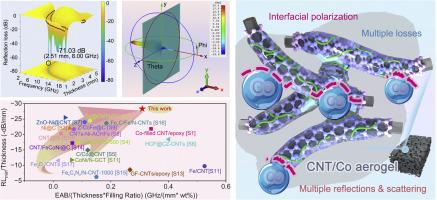Facile manufacturing of carbon nanotube/ZIF-67-derived cobalt composite aerogel with high-efficiency electromagnetic wave absorption
IF 11.2
1区 材料科学
Q1 MATERIALS SCIENCE, MULTIDISCIPLINARY
引用次数: 0
Abstract
Developing high-efficiency electromagnetic wave (EMW) absorbers by designing dielectric/magnetic components and microstructure in a straightforward, scalable method is highly desirable yet challenging. Here, we introduce a novel hierarchical composite aerogel-based EMW absorber composed of conductive carbon nanotubes (CNTs) and magnetic metal-organic framework (MOF) derivatives, integrated with sustainable cellulose nanofibers (CNF) derived carbon. This composite was prepared using a scalable freeze-casting followed by carbonization approach. Freeze casting enabled the creation of porous monoliths with high specific surface areas and customizable pore sizes and porosities, crucial for enhancing EMW reflection and scattering. Carbonization enhanced composite conductivity and stabilized the cobalt (Co)/carbon nanoparticles derived from ZIF-67 within the carbon matrix. CNF-derived carbon facilitated the efficient integration of ZIF-derived Co nanoparticles and CNTs, resulting in a robust 3D aerogel structure. The synergistic effects of CNT conductive paths and Co nanoparticles' magnetic losses provided an efficient route to enhance EMW absorption. Moreover, the creation of numerous heterogeneous interfaces augmented polarization losses, significantly enhancing EMW loss capability. Remarkably, the composite achieved outstanding EMW absorption, with a minimum reflection loss of -71.03 dB at a filling ratio of merely 10 wt.% and an effective absorption bandwidth of 4.64 GHz, comparable to leading EMW absorbers reported to date.

轻松制造具有高效电磁波吸收能力的碳纳米管/ZIF-67 衍生钴复合气凝胶
通过直接、可扩展的方法设计介电/磁性成分和微结构来开发高效电磁波(EMW)吸收器是非常理想的,但也是极具挑战性的。在此,我们介绍一种新型分层复合气凝胶电磁波吸收器,它由导电碳纳米管(CNT)和磁性金属有机框架(MOF)衍生物组成,并与可持续纤维素纳米纤维(CNF)衍生碳集成。这种复合材料的制备采用了可扩展的先冷冻铸造后碳化的方法。冷冻铸造法能够制造出具有高比表面积、可定制孔径大小和孔隙率的多孔单片,这对增强电磁波的反射和散射至关重要。碳化增强了复合材料的导电性,并将源自 ZIF-67 的钴(Co)/碳纳米粒子稳定在碳基质中。CNF 衍生的碳促进了 ZIF 衍生的钴纳米粒子和碳纳米管的有效整合,从而形成了坚固的三维气凝胶结构。CNT 导电路径和 Co 纳米粒子磁损的协同效应为增强电磁波吸收提供了有效途径。此外,大量异质界面的形成增加了极化损耗,显著提高了电磁波损耗能力。值得注意的是,该复合材料实现了出色的电磁波吸收能力,在填充率仅为 10 wt.% 的情况下,最小反射损耗为 -71.03 dB,有效吸收带宽为 4.64 GHz,与迄今报道的主要电磁波吸收器相当。
本文章由计算机程序翻译,如有差异,请以英文原文为准。
求助全文
约1分钟内获得全文
求助全文
来源期刊

Journal of Materials Science & Technology
工程技术-材料科学:综合
CiteScore
20.00
自引率
11.00%
发文量
995
审稿时长
13 days
期刊介绍:
Journal of Materials Science & Technology strives to promote global collaboration in the field of materials science and technology. It primarily publishes original research papers, invited review articles, letters, research notes, and summaries of scientific achievements. The journal covers a wide range of materials science and technology topics, including metallic materials, inorganic nonmetallic materials, and composite materials.
 求助内容:
求助内容: 应助结果提醒方式:
应助结果提醒方式:


